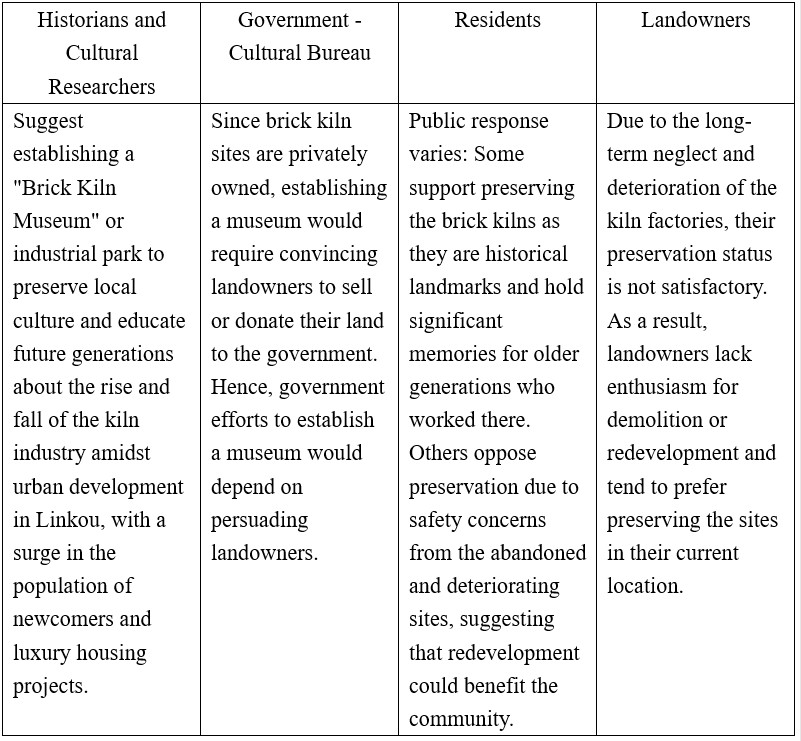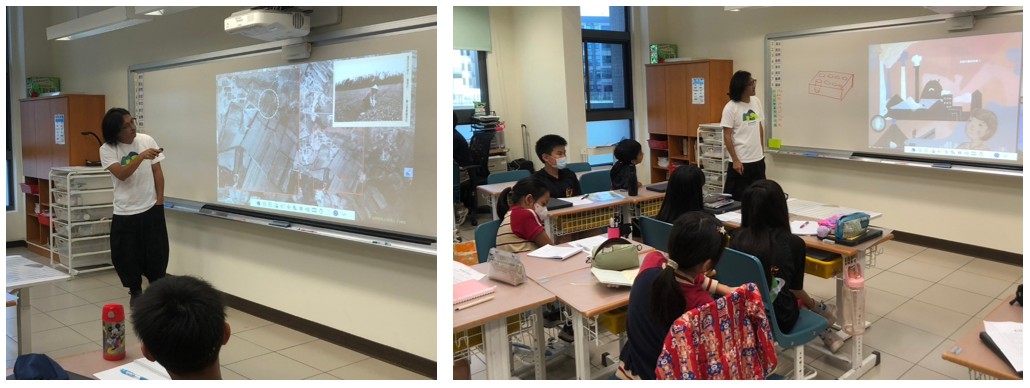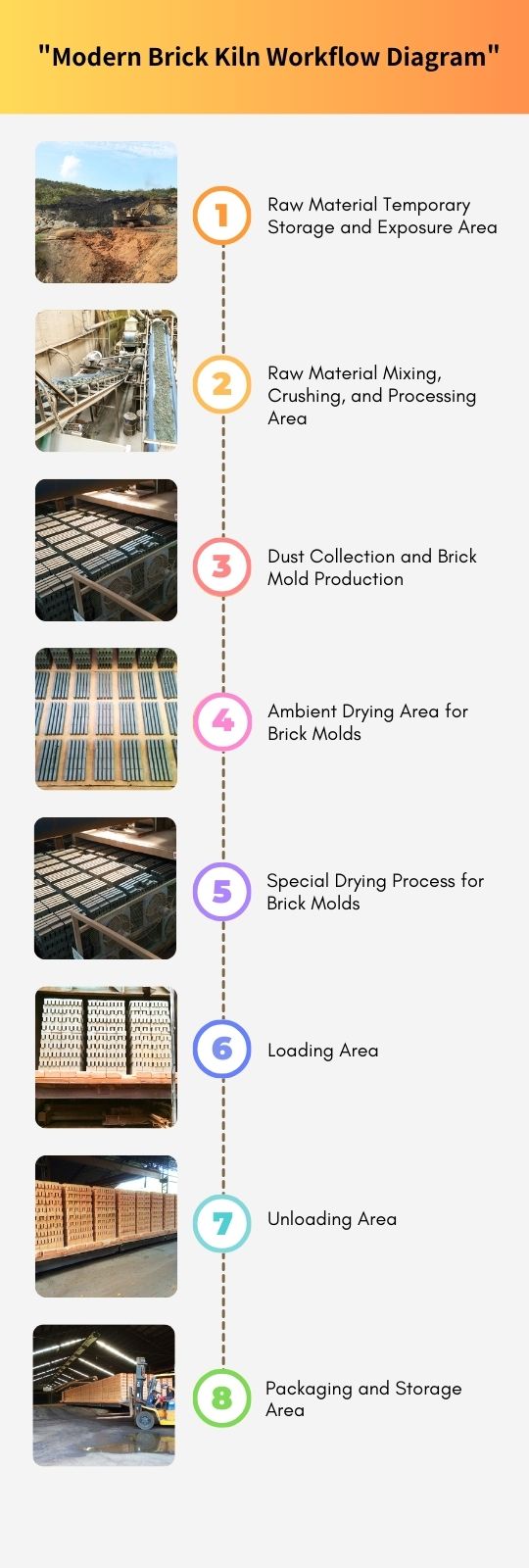► Current Situation of Brick Kiln Factories in Linkou
With the rise of tunnel kilns and electric kilns in Taiwan, which adopted mechanized mass production methods and utilized various raw materials including ordinary sand instead of red clay, production costs were significantly reduced. Consequently, traditional kiln industries in the Linkou area gradually disappeared. Production ceased in 1972, marking the end of the 18 years of glory days of brick kilns in Linkou.
As traditional kiln industries dwindled, most brick kilns were destroyed or demolished by landowners, replaced by new structures. Currently, there is only one intact brick kiln remaining in Linkou, adopting the common Bagua kiln form. However, abandoned and overgrown with weeds, with bricks and tiles damaged, it has become a kind of industrial ruin. It's hard to imagine the bustling scenes of workers bustling in and out of the kilns in the past, now forgotten by the world. Compared to the bustling activity nearby, these forgotten brick kilns stand in stark contrast.
.jpg)
► Controversies Surrounding Brick Kiln Preservation
Regarding the preservation or demolition of brick kiln factories, there are differing opinions from various parties, and consensus has yet to be reached:

► Lecture on Brick Kiln Preservation and Interviews with a Key Figure
The events surrounding the Bagua Kilns in Guishan have sparked a cultural storm in the vicinity of Linkou, prompting locals to deeply contemplate issues of cultural heritage preservation and rescue. Why have historical kilns turned into ruins? Initially, a group of local historians, known as the "Return to Guishan Front," petitioned the Cultural Affairs Bureau, hoping to protect the ancient kilns. Due to government plans for a future metro station and land acquisition for the metro line, there were intentions to demolish the historically significant Bagua Kilns for redevelopment.
In order to preserve local memory, the "Return to Guishan Front" historians requested a reassessment and preservation planning. Through online petitions, urgent appeals, and on-site protests, they finally gained the attention of local residents and relevant authorities, as well as the implementation of citizen participation. This allowed for more in-depth discussions on the subsequent planning for brick kiln preservation.
The development of land and the preservation of brick kiln culture in Linkou have always been contentious issues. We hope to find a balance between community and economic development. We do not want to wait until after the demolition of brick kiln monuments to appreciate their value. It would be like breaking an antique and then regretting it afterward. The subsequent restoration efforts would be a sad remedy. Therefore, we should voice our opinions early on to avoid future troubles after planning is completed. That's why we invited Simon, a member of the "Return to Guishan Front," to give a lecture and interview.

.jpg)
.jpg)
► Industrial History of Dapingding Area (Guishan and Linkou)
Fifty years ago, the main industries in the Linkou area were brick kiln production and tea cultivation. Therefore, most facilities were either brick kiln factories or tea fields. However, these two industries could not coexist in the same area because the carbon dioxide emissions from brick kiln firing would affect the growth and quality of tea leaves. As a result, Linkou became a stronghold for brick kiln factories. Even the location of our school, Linkou Kang Chiao, used to be a brick kiln factory. However, with the innovation in building materials and advancements in firing technology, the brick kiln industry gradually declined.
Attached is a video depicting the environmental and industrial changes in the Linkou Kang Chiao area over the past fifty years.

► Memorable Anecdotes from the Brick Factory
For the workers at the brick kiln factory, canvas was a vital tool. Since Linkou's terrain is characterized by foggy weather, if it rained and the bricks weren't covered with canvas, they would revert back to mud, rendering all their hard work futile. Therefore, this job relied heavily on weather conditions.
.jpg)
Local residents' lives were also closely intertwined with the Bagua Kilns. Inside the Bagua Kilns, the kilns were arched, but the top was flat. Linkou experiences frequent rain and humidity, making it difficult to dry clothes. It was common to see the elderly utilizing the high temperatures generated from the Bagua Kilns to dry clothes. Children didn't have many leisure activities and would often secretly roast sweet potatoes and taro over the kiln fire using wire skewers. However, when caught by adults, they would inevitably be scolded. With the disappearance of the brick kiln factories, these fond memories of the past can only be preserved in words.
.png)
► Protecting brick kilns is a long journey. What are Simon's thoughts on preserving brick kiln culture?
We can consider this from two perspectives. Firstly, in the current stage, the northern region still requires the red brick industry. Facing the remaining brick kiln factories, the government could provide industry subsidies and preserve several of them. Some houses still require red bricks for their walls, so operational brick factories can supply the demand in the north, reducing transportation costs. Additionally, in the process of transitioning, the red brick industry should adapt to environmental trends and grasp the pulse of the building materials market. For instance, the production process can be modified to reduce air pollution, and the weight of bricks can be lightened to align with modern lightweight construction trends, thus avoiding obsolescence.
Moreover, those brick kiln factories preserved intact, awaiting future planning, should not merely be a clash between land development and cultural preservation. Instead, citizen discussions should be open to finding innovative solutions. As consensus approaches, understanding the historical context is crucial. Currently, the predicament facing the LinKou community is the lack of attention from locals to this issue and the absence of comprehensive measures from relevant groups and government agencies. Convincing dissenting residents and landowners requires concrete and emotionally compelling action plans to visualize a future of cultural heritage.
Internationally, there are many practices Taiwan can draw inspiration from. Making brick kiln factories more accessible, such as transforming abandoned ones into parks, museums, or restaurants, allows people to connect with the brick kiln industry through daily life.
.png)
.png)
► What was the purpose of Simon establishing the "Return to Guishan Frontline" initially?
The initial purpose of Simon's establishment of the "Return to Guishan Frontline" was to explore local cultural and historical assets. They aimed to gather the local DNA through field investigations, ensuring that cultural and historical preservation is not exclusive to a minority. The organization regularly publishes materials to encourage public participation and response. The "Return to Guishan Frontline" operates as a large community, allocating tasks based on each partner's strengths, allowing everyone to work together to protect the culture of red bricks.
.png)
► What prompted Simon to invest in protecting brick kiln culture?
Growing up surrounded by natural landscapes, Simon was curious about the traditional occupations of the people around him, many of which were gradually fading away. He envisioned a future where history could coexist with modern life. Therefore, in recent years, he has not only co-founded magazines and online platforms for promotion with his peers but also been deeply involved in local education. Through collaborations with elementary and middle schools, he has organized a series of field trips and experiential activities. For example, in collaboration with local elementary schools, they jointly created a picture book about the brick kiln factories in Linkou.
.jpg)
► What are the innovative differences between the remaining brick kilns today and those in the past?
In the past, red bricks were all handmade. Every step, from cutting bricks to firing them red and shaping them, was done manually. When it rained at night, workers had to quickly cover the bricks drying outside with cloth to prevent damage. However, with the change of times, humans gradually invented machines. Therefore, most of the work in today's brick factories is done by machines. Located in the vicinity of Guishan in Linkou, the Lichang Brick Kiln is one of the few remaining modern operational factories. Nowadays, employees working in the factory only need to ensure the operation and maintenance of the machines, greatly reducing the need for manual labor compared to before.

